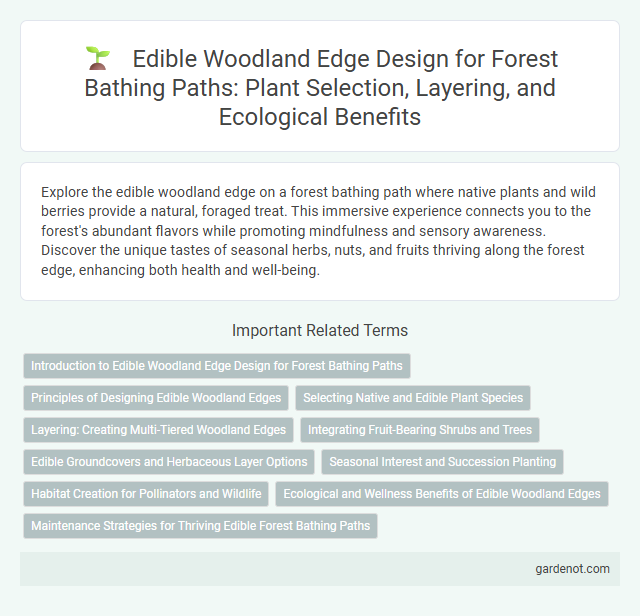Explore the edible woodland edge on a forest bathing path where native plants and wild berries provide a natural, foraged treat. This immersive experience connects you to the forest's abundant flavors while promoting mindfulness and sensory awareness. Discover the unique tastes of seasonal herbs, nuts, and fruits thriving along the forest edge, enhancing both health and well-being.
Introduction to Edible Woodland Edge Design for Forest Bathing Paths
Edible woodland edge design integrates native fruit-bearing shrubs, nuts, and herbs to create a sustainable, sensory-rich environment along forest bathing paths. This approach enhances biodiversity while providing seasonal edible plants that encourage mindful foraging and deepen nature connection. Strategic layering of flora supports soil health and attracts pollinators, promoting ecosystem resilience within forest bathing areas.
Principles of Designing Edible Woodland Edges
Designing edible woodland edges requires selecting diverse plant species that thrive in partial shade and support local wildlife, enhancing the ecosystem's resilience. Incorporating layers--from ground covers and shrubs to canopy trees--maximizes space and yields, while ensuring seasonal variety provides continuous harvest and habitat throughout the year. Soil health management and minimal disturbance practices are essential principles to sustain nutrient cycles and promote plant vitality in these boundary zones.
Selecting Native and Edible Plant Species
Selecting native and edible plant species for a forest bathing path promotes ecological balance and enhances visitor experience through natural foraging opportunities. Focus on species such as wild berries (Rubus spp.), edible ferns (Osmundaceae family), and native nut trees like hazelnuts (Corylus americana) to support local biodiversity. Prioritize plants adapted to local soil and climate conditions to ensure sustainable growth and maintain the health of the woodland edge ecosystem.
Layering: Creating Multi-Tiered Woodland Edges
Layering in edible woodland edges involves planting a diverse range of species across vertical tiers, such as ground covers, shrubs, and canopy trees, to maximize space and biodiversity. This multi-tiered approach enhances nutrient cycling, improves habitat complexity, and increases foraging opportunities for forest bathers. Thoughtful selection of native fruit-bearing shrubs, nut trees, and edible herbs ensures sustained yield while maintaining ecological balance along the forest bathing path.
Integrating Fruit-Bearing Shrubs and Trees
Integrating fruit-bearing shrubs and trees along a forest bathing path enhances biodiversity and offers natural foraging opportunities, enriching the sensory experience. Species such as elderberry, serviceberry, and hazelnut provide seasonal edible yields while supporting local wildlife habitats. Strategically planting these edible edges promotes ecological balance and fosters a deeper connection between visitors and the natural environment.
Edible Groundcovers and Herbaceous Layer Options
Edible groundcovers such as wild strawberries, creeping thyme, and sweet woodruff form a nutritious and low-maintenance layer in the woodland edge, enhancing biodiversity and foraging potential. Herbaceous plants like ramps, wild garlic, and sorrel thrive in shaded environments, providing flavorful, nutrient-rich options that support both wildlife and human use. Integrating these edible species into the forest bathing path promotes sustainable harvesting while enriching the sensory and ecological experience.
Seasonal Interest and Succession Planting
The edible woodland edge showcases a dynamic layering of fruit-bearing shrubs, nuts, and herbs that provide seasonal interest through vibrant autumn hues, spring blossoms, and summer harvests. Succession planting ensures continuous yield by strategically overlapping early, mid, and late-season species such as wild garlic, blackberries, and hazelnuts. This approach fosters biodiversity while enhancing the sensory experience along the forest bathing path.
Habitat Creation for Pollinators and Wildlife
The edible woodland edge serves as a vital habitat creation strategy, supporting diverse pollinators and wildlife by providing abundant nectar sources and protective shelter. Native shrubs, flowering plants, and fruit-bearing species foster biodiversity while enhancing ecosystem resilience. This specialized edge habitat boosts pollination efficiency and promotes sustainable environmental balance in forest bathing paths.
Ecological and Wellness Benefits of Edible Woodland Edges
Edible woodland edges enhance biodiversity by providing diverse habitats that support pollinators and wildlife, contributing to ecosystem balance. Consuming plants from these nutrient-rich zones offers natural antioxidants and vitamins, promoting improved immune function and mental well-being. Integrating edible woodland edges into forest bathing paths fosters a sensory connection with nature while supporting sustainable foraging practices.
Maintenance Strategies for Thriving Edible Forest Bathing Paths
Regular pruning and invasive species control are essential maintenance strategies for thriving edible forest bathing paths, ensuring optimal sunlight and nutrient availability. Incorporating organic mulches and natural fertilizers supports soil health and promotes robust growth of edible plants along the woodland edge. Seasonal monitoring and strategic replanting help sustain biodiversity and resilience, enhancing the overall sensory and ecological experience of the forest bathing path.
Edible woodland edge Infographic

 gardenot.com
gardenot.com